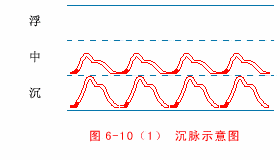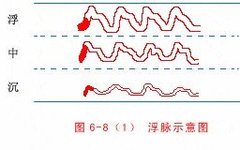Floating pulse (Fu Mai) is not commonly seen. It generally indicates exterior syndromes, which are referred to as Taiyang disease in the Shang Han Lun, including Taiyang wind and Taiyang cold. We might encounter floating pulses in cases of common colds, but this is rare because there are few individuals with a balanced constitution today. This is the first situation.

The second situation is that floating pulse can also be seen in cases of deficient Yang (Xu Yang) manifesting outwardly. If the pulse at the wrist (Chi Mai) is floating, it often indicates a chaotic fire (Xiang Huo) movement.
I once treated a patient who was quite robust and usually did not take his health seriously, thinking he was in great shape. One week, he felt weak and wondered if he was getting sick. When I checked his pulse, it was floating.
I said, “You have a cold; your pulse is floating.”
He replied, “But I don’t have any cold symptoms, no fever, no headache, just feel weak all over.”

I said, “Your pulse indicates a cold; you should take some cold medicine, like VC Yin Qiao Pian (Vitamin C and Yin Qiao tablets).” Since his pulse was not only floating but also slightly surging (Hong), I prescribed VC Yin Qiao Pian, which is a Chinese patent medicine based on the Yin Qiao San formula.
The next day he told me that the medicine really worked! I said, “This time you have a cold; next time if you feel weak, it may not work, you still need to check for a floating pulse.”
Deep pulse (Chen Mai), on the other hand, is more commonly encountered. Due to lifestyle issues, many people have deficient cold (Xu Han) and damp cold (Han Shi) constitutions, both of which present with deep pulses.
We define deep pulse as one that is located deeper in the body. In actual clinical practice, it is rare to find a pure deep pulse; it usually appears alongside other pulse types, which we call combined pulses (Xiang Jian Mai). This will be discussed in the pulse diagnosis class.

For example, some middle-aged men may experience benign prostatic hyperplasia (BPH) and their slow pulse is deep and strong. When you feel this pulse, you can ask them if they have prostate issues. Patients are often surprised that pulse diagnosis can reveal this.
Similarly, for middle-aged women with a damp cold constitution, if their pulse is deep and strong, it often indicates edema below the waist, which Western medicine refers to as “idiopathic edema.” Upon examination, their heart, liver, and kidneys are fine, but they have lower limb edema, with a notable characteristic of being “heavier at night and lighter in the morning.” We see many such cases.

Furthermore, in younger individuals aged 20-40, a small deep pulse, or what is mentioned in the Jin Gui Yao Lue as “diagnosing small accumulation pulse,” often indicates gynecological issues such as cysts or fibroids.
If a deep tight pulse is felt on one side, it indicates pain in the waist and legs on the same side, which is frequently observed in clinical practice. We mainly consider the pulses that accompany the deep pulse.
DisseminatingTCM health knowledge, promoting traditional Chinese culture,sharing health concepts, conveying care, and passing on health knowledge and traditional culture to more friends…
People are great because they have dreams; we are unique because we have love.
Liu Qing Ning: 186 9643 6785 or (WeChat ID)
Yang Shun Song: 138 7171 7447 or (WeChat ID)


